The Last Mile of China’s Low-Carbon Movement: Amplifying Climate Policy Through Cadre Performance Evaluation System
Abstract
1. Introduction
2. Policy Background, Framework, and Assumptions
2.1. Policy Background
2.1.1. Low Carbon City Policy
2.1.2. Cadre Performance Evaluation System Transformation
2.1.3. Stylized Facts
2.2. Theoretical Framework and Hypothesis
2.2.1. Framework
2.2.2. Hypothesis
3. Methods and Data
3.1. Identification Strategy
3.2. Variables and Data
3.2.1. Dependent Variable
3.2.2. Independent Variable
3.2.3. Mechanism Variables
3.2.4. Control Variables
3.2.5. Data Sources
4. Empirical Results
4.1. Benchmark Regression
4.2. Parallel Trend Test
4.3. Placebo Test
4.4. Robustness Test
4.4.1. Replacing the Dependent Variable
4.4.2. Adjusting the Sample
4.4.3. Considering Heterogeneous Treatment Effects
4.4.4. Reducing Sample Bias
4.4.5. Excluding the Interference of Related Policies
4.4.6. Considering Transportation and Natural Factors
4.4.7. Using the Double Machine Learning Model
4.4.8. Using the Synthetic Difference-in-Differences Model
5. Synergistic Mechanism of LCCP and CPEST
5.1. The Impact of the Timing
5.2. The Impact of Goal Consistency
5.3. Mechanism Test
5.3.1. Government Aspect: Governance Mechanism
5.3.2. Market Aspect: Economic Mechanism
5.4. Heterogeneity Analysis
6. Conclusions, Discussion, and Policy Implications
6.1. Conclusions
6.2. Discussion
6.3. Policy Implications
Supplementary Materials
Author Contributions
Funding
Institutional Review Board Statement
Informed Consent Statement
Data Availability Statement
Acknowledgments
Conflicts of Interest
References
- Mora, C.; Spirandelli, D.; Franklin, E.C.; Lynham, J.; Kantar, M.B.; Miles, W.; Smith, C.Z.; Freel, K.; Moy, J.; Louis, L.V.; et al. Broad threat to humanity from cumulative climate hazards intensified by greenhouse gas emissions. Nat. Clim. Change 2018, 8, 1062–1071. [Google Scholar] [CrossRef]
- Masson-Delmotte, V.; Zhai, P.; Pörtner, H.-O.; Roberts, D.; Skea, J.; Shukla, P.R. Global Warming of 1.5 C: IPCC Special Report on Impacts of Global Warming of 1.5 C Above Pre-Industrial Levels in Context of Strengthening Response to Climate Change, Sustainable Development, and Efforts to Eradicate Poverty; Cambridge University Press: Cambridge, UK, 2022. [Google Scholar]
- Song, Q.J.; Liu, T.L.; Qi, Y. Policy innovation in low carbon pilot cities: Lessons learned from China. Urban Clim. 2021, 39, 100936. [Google Scholar] [CrossRef]
- Guo, S.H.; Song, Q.J.; Qi, Y. Innovation or implementation? Local response to low-carbon policy experimentation in China. Rev. Policy Res. 2021, 38, 555–569. [Google Scholar] [CrossRef]
- Wang, C.; Lin, J.; Cai, W.J.; Liao, H. China’s carbon mitigation strategies: Enough? Energy Policy 2014, 73, 47–56. [Google Scholar] [CrossRef]
- Lindblom, C.E. The Policy-Making Process; Prentice-Hall: Hoboken, NJ, USA, 1968. [Google Scholar]
- Pressman, J.L.; Wildaysky, A.B. Implementation (Third Edition Expanded); University of California Press: Berkeley, CA, USA, 1984. [Google Scholar]
- Hjern, B. Implementation research—The link gone missing. J. Public Policy 1982, 2, 301–308. [Google Scholar] [CrossRef]
- Lipsky, M. Street-Level Bureaucracy: Dilemmas of the Individual in Public Service; Russell Sage Foundation: New York, NY, USA, 2010. [Google Scholar]
- Gilmore, E.A.; Buhaug, H. Climate mitigation policies and the potential pathways to conflict: Outlining a research agenda. Wiley Interdiscip. Rev.-Clim. Change 2021, 12, e722. [Google Scholar] [CrossRef]
- Peterson, T.D.; Rose, A.Z. Reducing conflicts between climate policy and energy policy in the US: The important role of the states. Energy Policy 2006, 34, 619–631. [Google Scholar] [CrossRef]
- van der Voorn, T.; Svenfelt, Å.; Björnberg, K.E.; Fauré, E.; Milestad, R. Envisioning carbon-free land use futures for Sweden: A scenario study on conflicts and synergies between environmental policy goals. Reg. Environ. Change 2020, 20, 35. [Google Scholar] [CrossRef]
- Markard, J.; Rosenbloom, D. Political conflict and climate policy: The European emissions trading system as a Trojan Horse for the low-carbon transition? Clim. Policy 2020, 20, 1092–1111. [Google Scholar] [CrossRef]
- Yun, S.J.; Ku, D.; Han, J.Y. Climate policy networks in South Korea: Alliances and conflicts. Clim. Policy 2014, 14, 283–301. [Google Scholar] [CrossRef]
- Wu, Q.Y.; Tan, C.; Wang, D.P.; Wu, Y.T.; Meng, J.; Zheng, H.R. How carbon emission prices accelerate net zero: Evidence from China’s coal-fired power plants. Energy Policy 2023, 177, 113524. [Google Scholar] [CrossRef]
- Wu, S.; Hu, F.F.; Zhang, Z.J. Visible hand or invisible hand in climate governance? Evidence from China. Renew. Sustain. Energy Rev. 2024, 204, 114798. [Google Scholar] [CrossRef]
- Gilley, B. Authoritarian environmentalism and China’s response to climate change. Environ. Politics 2012, 21, 287–307. [Google Scholar] [CrossRef]
- Rao, Y.C.; Wang, X.L.; Li, H.K.; Ruan, Y.J. How can the Pearl River Delta urban agglomeration achieve the carbon peak target: Based on the perspective of an optimal stable economic growth path. J. Clean. Prod. 2024, 439, 140879. [Google Scholar] [CrossRef]
- Song, Y.; Wei, Y.C.; Zhu, J.; Liu, J.; Zhang, M. Environmental regulation and economic growth: A new perspective based on technical level and healthy human capital. J. Clean. Prod. 2021, 318, 128520. [Google Scholar] [CrossRef]
- Ostrom, E. Background on the Institutional Analysis and Development Framework. Policy Stud. J. 2011, 39, 7–27. [Google Scholar] [CrossRef]
- Ostrom, E. Governing the Commons: The Evolution of Institutions for Collective Action; Cambridge University Press: New York, NY, USA, 1990. [Google Scholar]
- Wu, J.X.; Nie, X.; Wang, H. Are policy mixes in energy regulation effective in curbing carbon emissions? Insights from China’s energy regulation policies. J. Policy Anal. Manag. 2023, 43, 1152–1184. [Google Scholar] [CrossRef]
- Zhang, X.F.; Fan, D.C. Collaborative emission reduction research on dual-pilot policies of the low-carbon city and smart city from the perspective of multiple innovations. Urban Clim. 2023, 47, 101364. [Google Scholar] [CrossRef]
- Flanagan, K.; Uyarra, E.; Laranja, M. Reconceptualising the ‘policy mix’for innovation. Res. Policy 2011, 40, 702–713. [Google Scholar] [CrossRef]
- Rogge, K.S.; Reichardt, K. Policy mixes for sustainability transitions: An extended concept and framework for analysis. Res. Policy 2016, 45, 132–147. [Google Scholar] [CrossRef]
- Feng, T.; Lin, Z.G.; Du, H.B.; Qiu, Y.M.; Zuo, J. Does low-carbon pilot city program reduce carbon intensity? Evidence from Chinese cities. Res. Int. Bus. Financ. 2021, 58, 101450. [Google Scholar] [CrossRef]
- Bali, A.S.; Howlett, M.; Ramesh, M. Unpacking policy portfolios: Primary and secondary aspects of tool use in policy mixes. J. Asian Public Policy 2022, 15, 321–337. [Google Scholar] [CrossRef]
- Wang, Y.F.; Song, Q.J.; He, J.J.; Qi, Y. Developing low-carbon cities through pilots. Clim. Policy 2015, 15, S81–S103. [Google Scholar] [CrossRef]
- Li, H.; Zhou, L.-A. Political turnover and economic performance: The incentive role of personnel control in China. J. Public Econ. 2005, 89, 1743–1762. [Google Scholar] [CrossRef]
- Zeng, J.J.; Bao, R. Moving beyond gross domestic product: The impacts of gross domestic product-centric cadre performance targets shift on environmental protection. Public Adm. Dev. 2024, 44, 397–411. [Google Scholar] [CrossRef]
- O’Toole, L.J., Jr. Research on policy implementation: Assessment and prospects. J. Public Adm. Res. Theory 2000, 10, 263–288. [Google Scholar] [CrossRef]
- Ostrom, E. Understanding Institutional Diversity; Princeton University Press: Princeton, NJ, USA, 2009. [Google Scholar]
- Bodin, Ö. Collaborative environmental governance: Achieving collective action in social-ecological systems. Science 2017, 357, aan1114. [Google Scholar] [CrossRef]
- Ostrom, E. A General Framework for Analyzing Sustainability of Social-Ecological Systems. Science 2009, 325, 419–422. [Google Scholar] [CrossRef]
- Alexander, E. How Organizations Act Together: Interorganizational Coordination in Theory and Practice, 1st ed.; Routledge: London, UK, 1995. [Google Scholar]
- Mitnick, B.M.; Backoff, R. The incentive relation in implementation. In Public Policy Implementation; Edwards, G.C., III, Ed.; Congressional Quarterly Press: Washington, DC, USA, 1984; Volume 3. [Google Scholar]
- Lindenberg, S.; Steg, L. Normative, gain and hedonic goal frames guiding environmental behavior. J. Soc. Issues 2007, 63, 117–137. [Google Scholar] [CrossRef]
- Blackman, A.; Li, Z.Y.; Liu, A.T.A. Efficacy of Command-and-Control and Market-Based Environmental Regulation in Developing Countries. Annu. Rev. Resour. Econ. 2018, 10, 381–404. [Google Scholar] [CrossRef]
- Liu, Z.; Wang, H.; Zhou, Y. Assessment of emission reduction effects in China’s economic transformation and sustainable development strategy. Ecol. Indic. 2024, 167, 112522. [Google Scholar] [CrossRef]
- Grossman, G.M.; Krueger, A.B. Economic growth and the environment. Q. J. Econ. 1995, 110, 353–377. [Google Scholar] [CrossRef]
- Chen, M.Q. A study of low-carbon development, urban innovation and industrial structure upgrading in China. Int. J. Low-Carbon Technol. 2022, 17, 185–195. [Google Scholar] [CrossRef]
- Pan, A.; Zhang, W.N.; Shi, X.P.; Dai, L. Climate policy and low-carbon innovation: Evidence from low-carbon city pilots in China. Energy Econ. 2022, 112, 106129. [Google Scholar] [CrossRef]
- Tang, P.C.; Yang, S.W.; Shen, J.; Fu, S.K. Does China’s low-carbon pilot programme really take off? Evidence from land transfer of energy-intensive industry. Energy Policy 2018, 114, 482–491. [Google Scholar] [CrossRef]
- Chen, X.; Jiang, H.C.; Ling, J.H. Addressing Multitasking Problems through Promotion Incentives: An Empirical Study of Local Governments in China. Public Perform. Manag. Rev. 2024, 47, 654–680. [Google Scholar] [CrossRef]
- Shao, S.; Liu, J.H.; Geng, Y.; Miao, Z.; Yang, Y.C. Uncovering driving factors of carbon emissions from China’s mining sector. Appl. Energy 2016, 166, 220–238. [Google Scholar] [CrossRef]
- Dong, F.; Yu, B.L.; Hadachin, T.; Dai, Y.J.; Wang, Y.; Zhang, S.N.; Long, R.Y. Drivers of carbon emission intensity change in China. Resour. Conserv. Recycl. 2018, 129, 187–201. [Google Scholar] [CrossRef]
- Chang, H.; Ding, Q.Y.; Zhao, W.Z.; Hou, N.; Liu, W.W. The digital economy, industrial structure upgrading, and carbon emission intensity—Empirical evidence from China’s provinces. Energy Strategy Rev. 2023, 50, 101218. [Google Scholar] [CrossRef]
- Lyu, J.; Liu, T.L.; Cai, B.F.; Qi, Y.; Zhang, X.L. Heterogeneous effects of China’s low-carbon city pilots policy. J. Environ. Manag. 2023, 344, 118329. [Google Scholar] [CrossRef]
- Dong, Z.Q.; He, Y.D.; Wang, H.; Wang, L.H. Is there a ripple effect in environmental regulation in China?—Evidence from the local-neighborhood green technology innovation perspective. Ecol. Indic. 2020, 118, 106773. [Google Scholar] [CrossRef]
- Wu, N.; Liu, Z. Higher education development, technological innovation and industrial structure upgrade. Technol. Forecast. Soc. Change 2021, 162, 120400. [Google Scholar] [CrossRef]
- Lu, J.; Wang, T.H.; Liu, X.H. Can environmental governance policy synergy reduce carbon emissions? Econ. Anal. Policy 2023, 80, 570–585. [Google Scholar] [CrossRef]
- Nunn, N.; Qian, N. US Food Aid and Civil Conflict. Am. Econ. Rev. 2014, 104, 1630–1666. [Google Scholar] [CrossRef]
- Ansoff, H.I. Corporate Strategy: An Analytic Approach to Business Policy for Growth and Expansion; McGraw-Hill: New York, NY, USA, 1965. [Google Scholar]
- Brunekreef, B.; Holgate, S.T. Air pollution and health. Lancet 2002, 360, 1233–1242. [Google Scholar] [CrossRef]
- Baker, A.C.; Larcker, D.F.; Wang, C.C.Y. How much should we trust staggered difference-in-differences estimates? J. Financ. Econ. 2022, 144, 370–395. [Google Scholar] [CrossRef]
- Sun, L.Y.; Abraham, S. Estimating dynamic treatment effects in event studies with heterogeneous treatment effects. J. Econom. 2021, 225, 175–199. [Google Scholar] [CrossRef]
- Chernozhukov, V.; Chetverikov, D.; Demirer, M.; Duflo, E.; Hansen, C.; Newey, W.; Robins, J. Double/debiased machine learning for treatment and structural parameters. Econom. J. 2018, 21, C1–C68. [Google Scholar] [CrossRef]
- Sorrell, S.; Smith, A.; Betz, R.; Walz, R.; Boemare, C.; Quirion, P.; Sijm, J.; Mavrakis, D.; Konidari, P.; Vassos, S. Interaction in EU Climate Policy, Final Report to DG Research Under the Framework V Project Interaction in EU Climate Policy; University of Sussex: Brighton, UK, 2003. [Google Scholar]
- Li, B.; Han, Y.K.; Wang, C.S.; Sun, W. Did civilized city policy improve energy efficiency of resource-based cities? Prefecture-level evidence from China. Energy Policy 2022, 167, 113081. [Google Scholar] [CrossRef]
- Zhu, X.W.; Yang, Y.P. The pollution reduction effect of official turnover: Evidence from China. Sci. Total Environ. 2023, 868, 161459. [Google Scholar] [CrossRef]
- Ellerman, A.D.; Convery, F.J.; De Perthuis, C. Pricing Carbon: The European Union Emissions Trading Scheme; Cambridge University Press: Cambridge, UK, 2010. [Google Scholar]
- Phuong, L.T.H.; Biesbroek, G.R.; Wals, A.E.J. Barriers and enablers to climate change adaptation in hierarchical governance systems: The case of Vietnam. J. Environ. Policy Plan. 2018, 20, 518–532. [Google Scholar] [CrossRef]
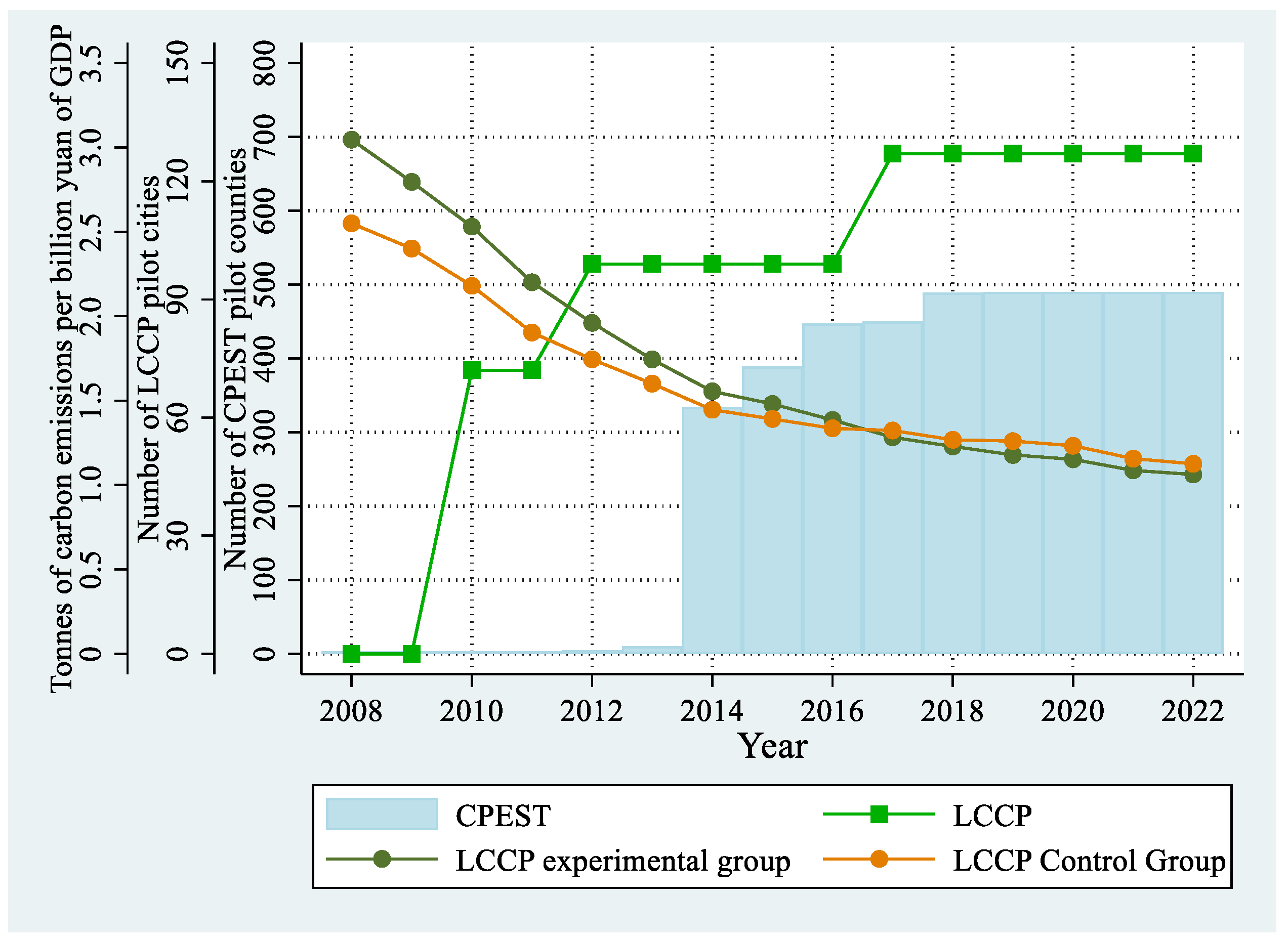
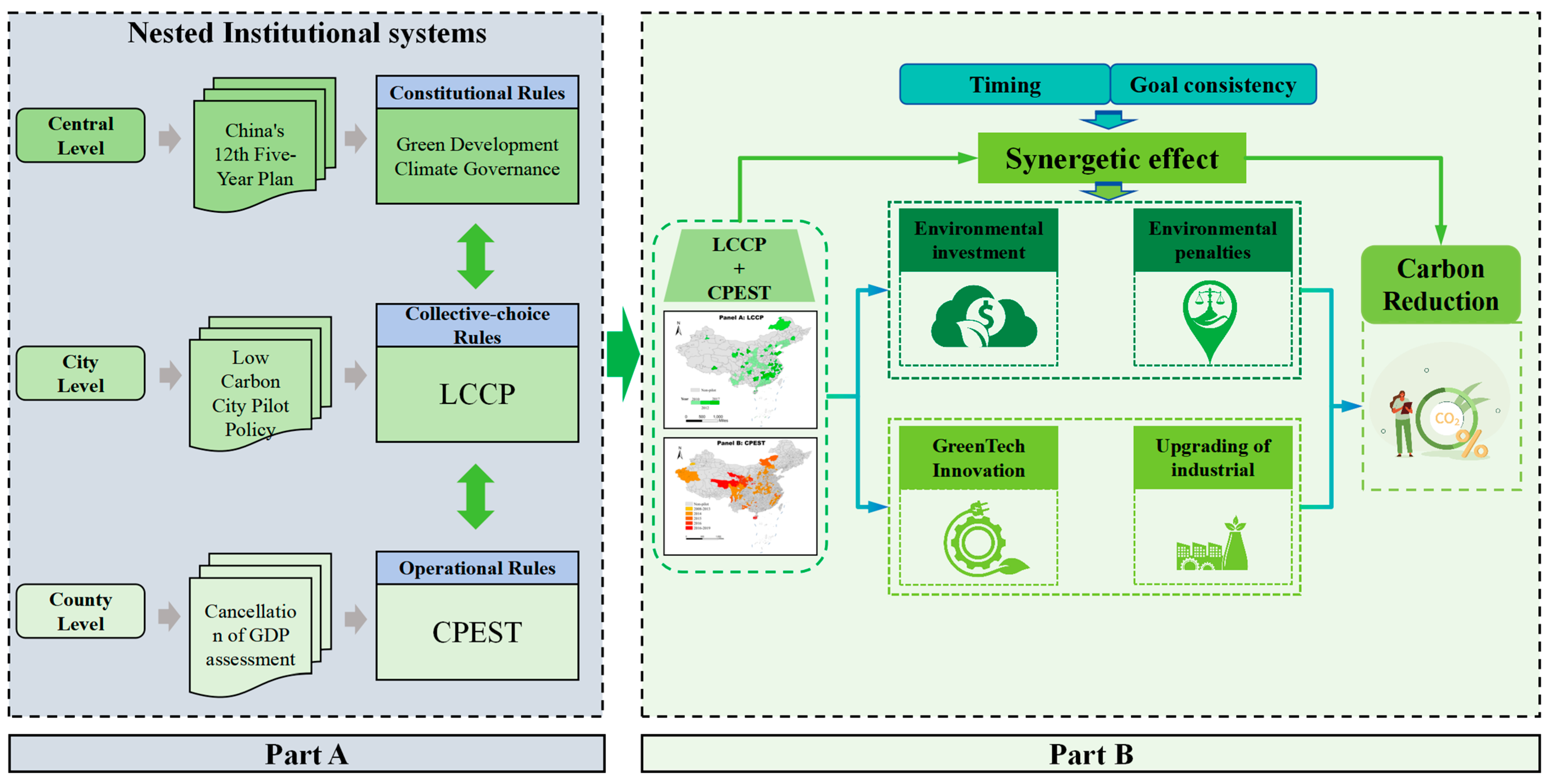
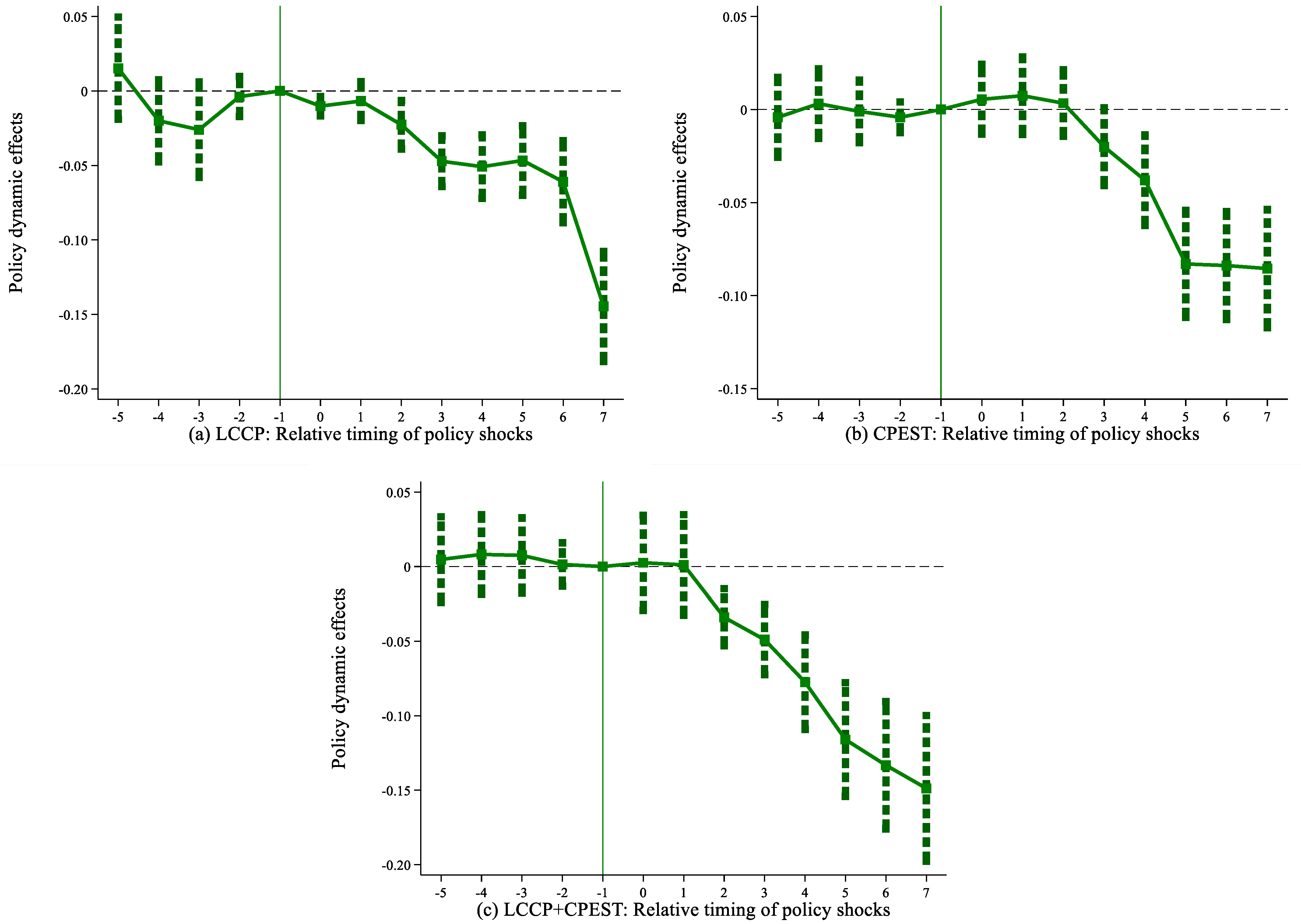
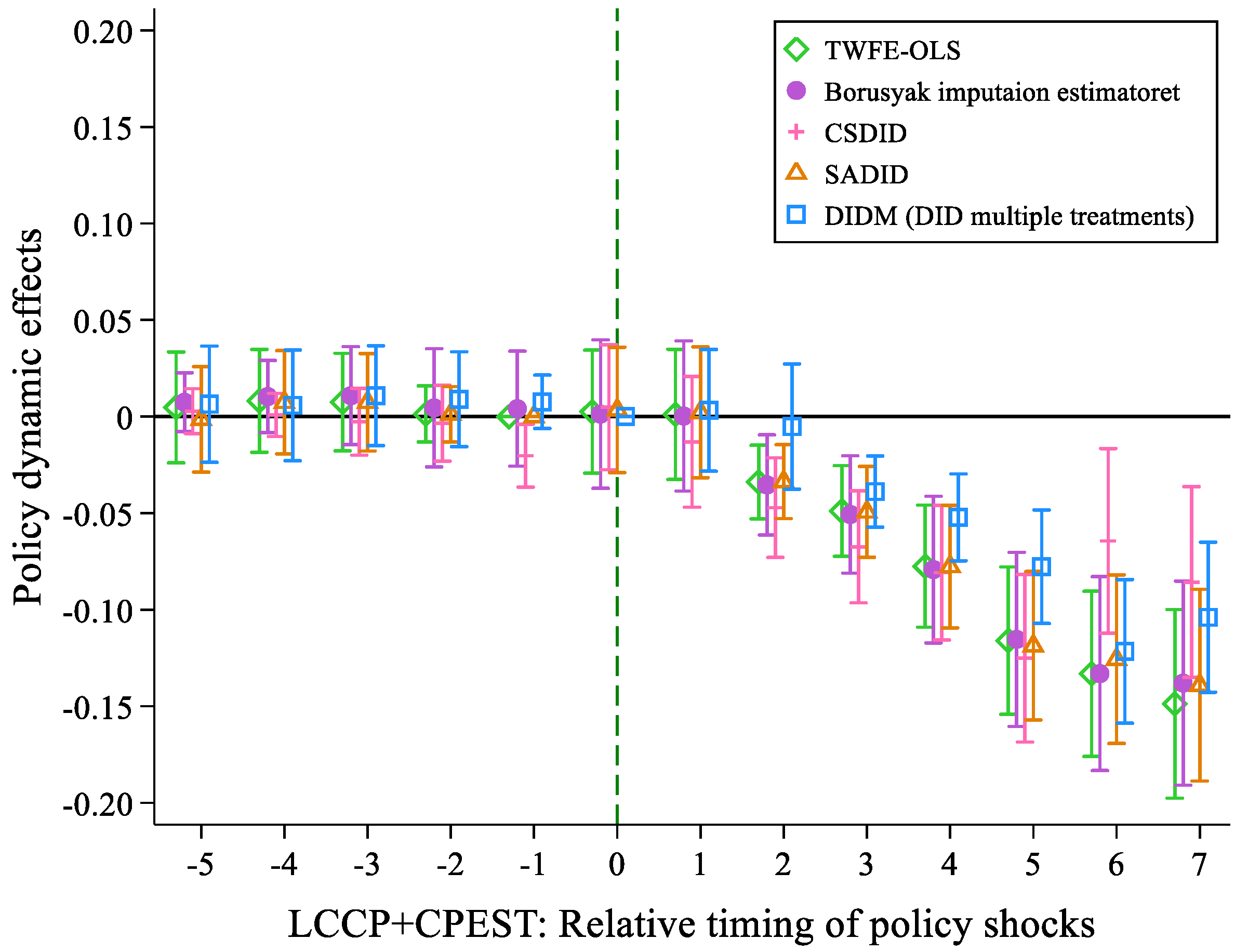

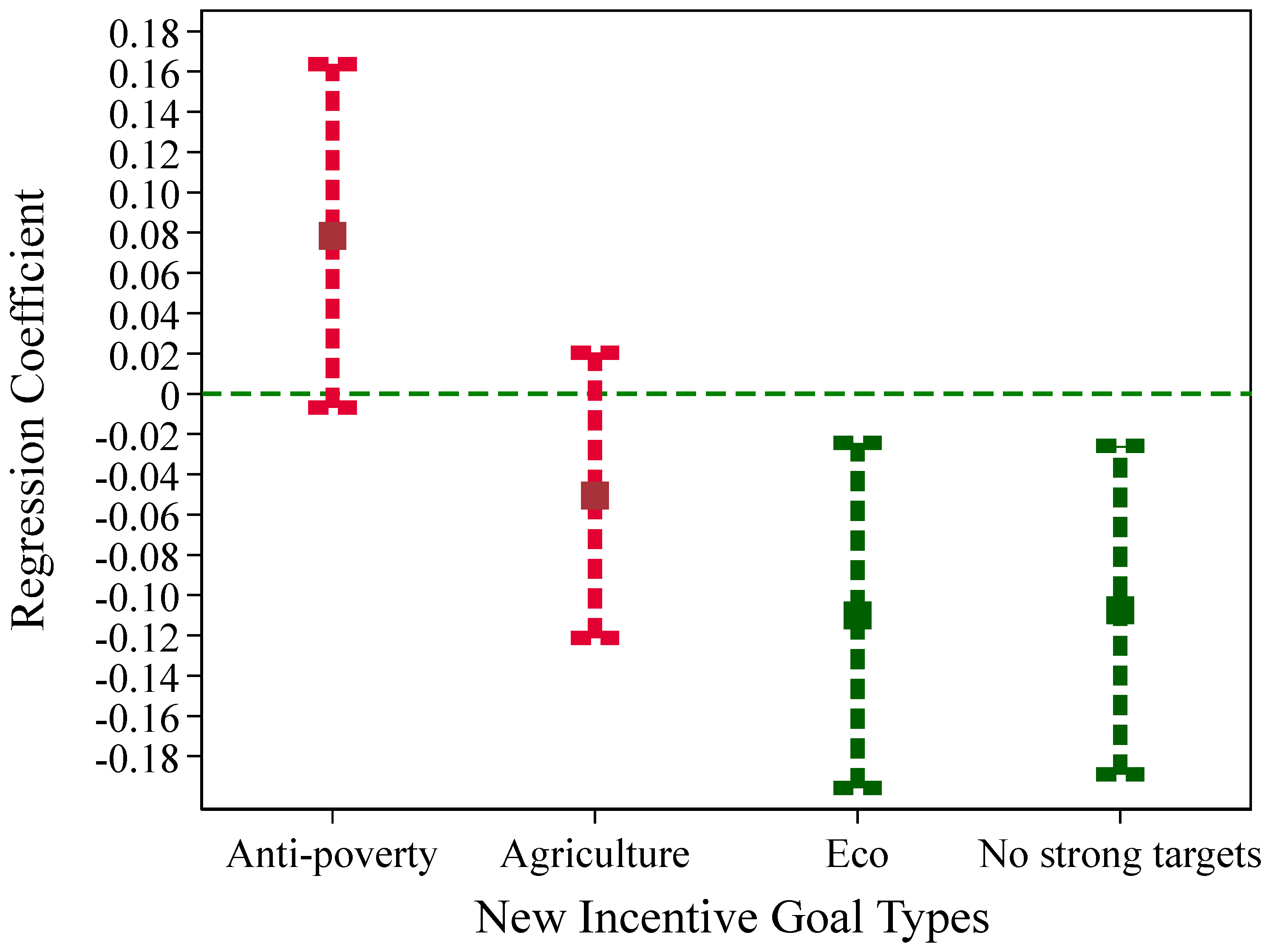
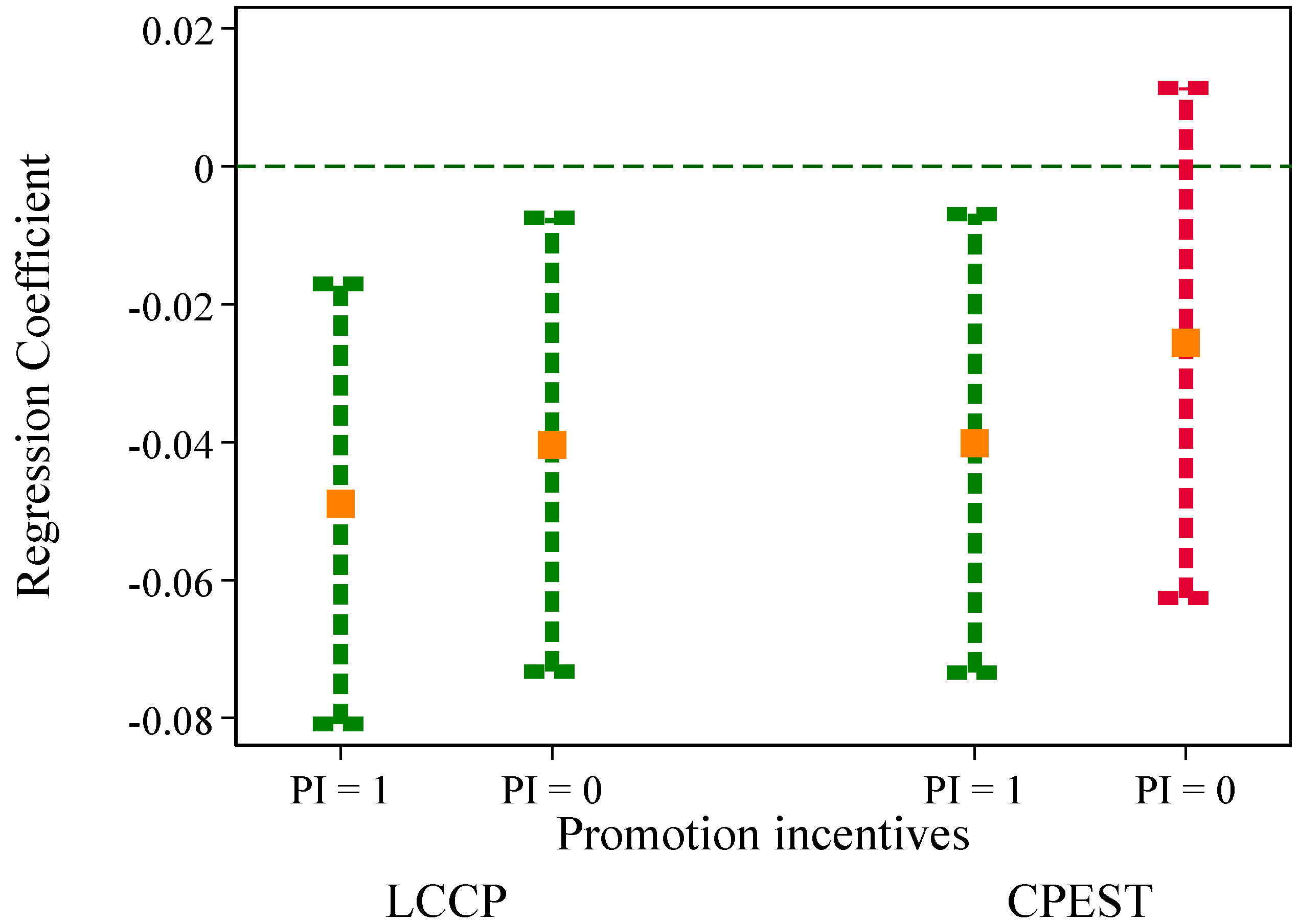
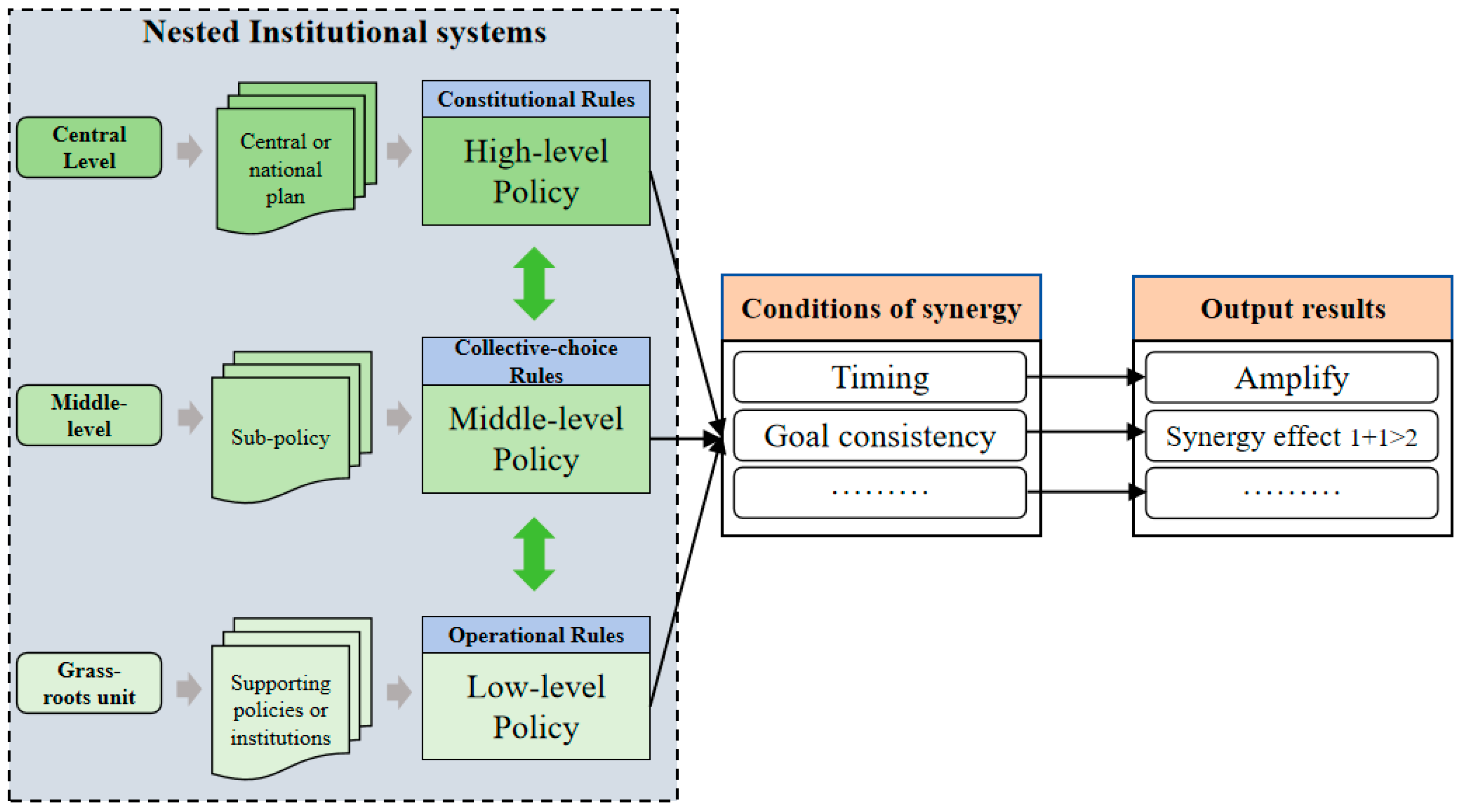
| Variable | CE | |||||
|---|---|---|---|---|---|---|
| (1) | (2) | (3) | (4) | (5) | (6) | |
| LCCP | −0.1071 *** (0.0142) | −0.0396 *** (0.0116) | ||||
| CPEST | −0.0810 *** (0.0158) | −0.0343 *** (0.0125) | ||||
| LCCP + CPEST | −0.1211 *** (0.0198) | −0.0698 *** (0.0168) | ||||
| Controls | No | No | No | Yes | Yes | Yes |
| County | Yes | Yes | Yes | Yes | Yes | Yes |
| Year | Yes | Yes | Yes | Yes | Yes | Yes |
| Mixes (linear summation) | −0.1881 | −0.0739 | ||||
| Obs | 23,505 | 23,505 | 23,505 | 23,505 | 23,505 | 23,505 |
| R2 | 0.9288 | 0.9285 | 0.9285 | 0.9509 | 0.9508 | 0.9509 |
| Variable | CE | CE |
|---|---|---|
| (1) | (2) | |
| LCCP before CPEST | −0.0735 *** (0.0125) | |
| CPEST before LCCP | −0.0518 *** (0.0177) | |
| Anti-poverty | 0.0784 (0.0501) | |
| Agriculture | −0.0505 (0.0177) | |
| Eco | −0.1101 ** (0.0503) | |
| No strong targets | −0.1075 ** (0.0479) | |
| Controls | Yes | Yes |
| County | Yes | Yes |
| Year | Yes | Yes |
| Obs | 23,505 | 23,505 |
| R2 | 0.9509 | 0.9511 |
| Variable | EI | EP | ||||
|---|---|---|---|---|---|---|
| (1) | (2) | (3) | (4) | (5) | (6) | |
| LCCP × M | −0.4525 ** (0.2246) | −0.0044 *** (0.0012) | ||||
| CPEST × M | −0.2819 (0.2744) | −0.0032 (0.0032) | ||||
| (LCCP + CPEST) × M | −1.0195 ** (0.4546) | −0.0070 ** (0.0017) | ||||
| Controls | Yes | Yes | Yes | Yes | Yes | Yes |
| County | Yes | Yes | Yes | Yes | Yes | Yes |
| Year | Yes | Yes | Yes | Yes | Yes | Yes |
| Obs | 18,585 | 18,585 | 18,585 | 14,550 | 14,550 | 14,550 |
| R2 | 0.9504 | 0.9503 | 0.9504 | 0.9546 | 0.9546 | 0.9546 |
| Variable | GTI | UIS | ||||
|---|---|---|---|---|---|---|
| (1) | (2) | (3) | (4) | (5) | (6) | |
| LCCP × M | −0.0162 *** (0.0041) | −0.2089 *** (0.0261) | ||||
| CPEST × M | −0.0162 *** (0.0054) | −0.2054 *** (0.0260) | ||||
| (LCCP + CPEST) × M | −0.0284 *** (0.0060) | −0.2125 *** (0.0262) | ||||
| Controls | Yes | Yes | Yes | Yes | Yes | Yes |
| County | Yes | Yes | Yes | Yes | Yes | Yes |
| Year | Yes | Yes | Yes | Yes | Yes | Yes |
| Obs | 17,860 | 17,860 | 17,860 | 23,505 | 23,505 | 23,505 |
| R2 | 0.9550 | 0.9549 | 0.9550 | 0.9520 | 0.9520 | 0.9521 |
| Variable | RC-Yes | RC-No | OIB-Yes | OIB-No | PI-High | PI-Low |
|---|---|---|---|---|---|---|
| (1) | (2) | (3) | (4) | (5) | (6) | |
| LCCP + CPEST | −0.0964 *** (0.0422) | −0.0483 *** (0.0169) | −0.1466 *** (0.0324) | −0.0370 * (0.0192) | −0.1024 *** (0.0241) | −0.0291 (0.0224) |
| Controls | Yes | Yes | Yes | Yes | Yes | Yes |
| County | Yes | Yes | Yes | Yes | Yes | Yes |
| Year | Yes | Yes | Yes | Yes | Yes | Yes |
| Obs | 10,200 | 13,305 | 6450 | 17,055 | 12,015 | 11,490 |
| R2 | 0.9508 | 0.9515 | 0.9526 | 0.9513 | 0.9486 | 0.9538 |
| Fisher’s Permutation Test | 0.0480 *** | 0.1100 *** | 0.0730 *** | |||
Disclaimer/Publisher’s Note: The statements, opinions and data contained in all publications are solely those of the individual author(s) and contributor(s) and not of MDPI and/or the editor(s). MDPI and/or the editor(s) disclaim responsibility for any injury to people or property resulting from any ideas, methods, instructions or products referred to in the content. |
© 2025 by the authors. Licensee MDPI, Basel, Switzerland. This article is an open access article distributed under the terms and conditions of the Creative Commons Attribution (CC BY) license (https://creativecommons.org/licenses/by/4.0/).
Share and Cite
Chen, Y.; Ye, Q. The Last Mile of China’s Low-Carbon Movement: Amplifying Climate Policy Through Cadre Performance Evaluation System. Sustainability 2025, 17, 5232. https://doi.org/10.3390/su17125232
Chen Y, Ye Q. The Last Mile of China’s Low-Carbon Movement: Amplifying Climate Policy Through Cadre Performance Evaluation System. Sustainability. 2025; 17(12):5232. https://doi.org/10.3390/su17125232
Chicago/Turabian StyleChen, Yongzhou, and Qiuzhi Ye. 2025. "The Last Mile of China’s Low-Carbon Movement: Amplifying Climate Policy Through Cadre Performance Evaluation System" Sustainability 17, no. 12: 5232. https://doi.org/10.3390/su17125232
APA StyleChen, Y., & Ye, Q. (2025). The Last Mile of China’s Low-Carbon Movement: Amplifying Climate Policy Through Cadre Performance Evaluation System. Sustainability, 17(12), 5232. https://doi.org/10.3390/su17125232





